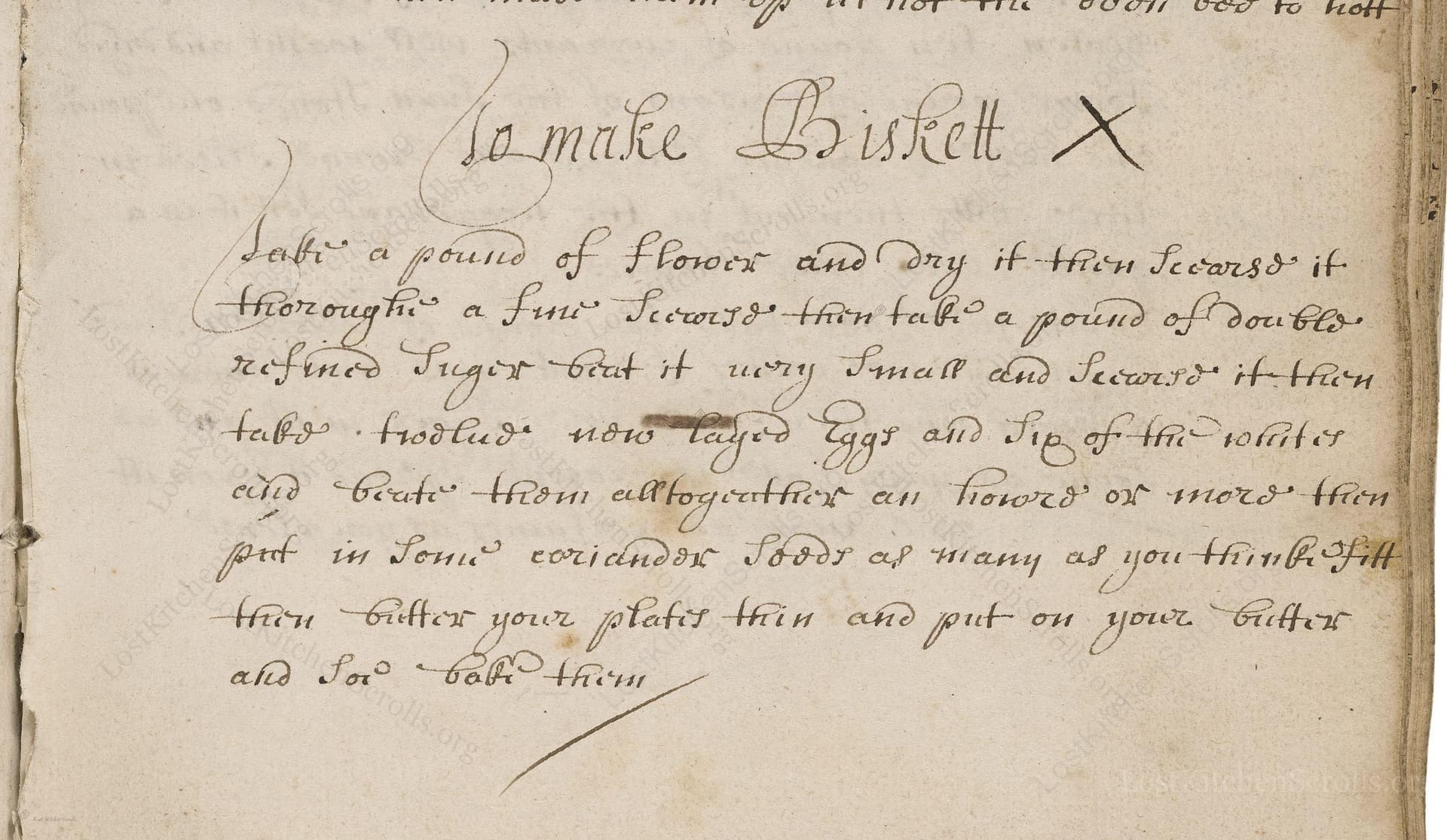To Make Bisckett
From the treasured pages of Cookery book of Ann Goodenough
Written by Ann Goodenough

To Make Bisckett
"Take a pound of Flower and dry it then Seavers it Thoroughly a fine Seavers then take a pound of double refined Suger but it very Small and Seaverd itt then take twelve new laidd Eggs and the tip of the whitts and beeate them alltogether an hower or more then put in Some coriandor Seads as many as you think fitt then butterr your plates thin and put on your batter and Soe bake them"
Note on the Original Text
The recipe is written in 18th-century English, capturing the straightforward, conversational style of domestic manuscript collections. Spellings such as 'bisckett,' 'flower' for flour, 'whitts' for whites, and 'beeate' for beat reflect the non-standardized orthography of the time. Instructions assume the cook’s familiarity with techniques such as long egg beating and fine sifting. The absence of rising agents or precise baking times is typical—these details were often left to the cook’s personal apprenticeship and intuition.

Title
Cookery book of Ann Goodenough (1738)
You can also click the book image above to peruse the original tome
Writer
Ann Goodenough
Era
1738
Publisher
Unknown
Background
A delightful journey into the kitchens of early 18th-century England, this collection captures the flair and flavors of its time with recipes crafted by the inventive Ann Goodenough. Expect a charming medley of hearty roasts, comforting pies, and time-honored confections, perfect for those wishing to dine as they did in Georgian days.
Kindly made available by
Folger Shakespeare Library
This recipe hails from the English manuscript collection of Ann Goodenough, active between 1700 and 1775. During this time, biscuits ('bisckett') were evolving from medieval rusks and simple breads into the sweet treats we recognize today. Recipes like this one were passed down through families or recorded in household books and represent the move toward lighter, spiced, and more refined baked goods. The use of coriander seeds demonstrates the period's penchant for aromatic and exotic spices, reflecting both culinary fashion and the reach of global trade.

In the 18th century, this biscuit would have been made with a simple wooden or earthenware mixing bowl and a birch or wire whisk for the long, vigorous beating of eggs. Sifting (or 'seavering') was done with fine mesh sieves. The biscuits were baked on buttered tin or ceramic plates in a wood-fired or coal-fired oven, which required close attention for even cooking.
Prep Time
25 mins
Cook Time
15 mins
Servings
36
We've done our best to adapt this historical recipe for modern kitchens, but some details may still need refinement. We warmly welcome feedback from fellow cooks and culinary historians — your insights support the entire community!
Ingredients
- 1 lb (16 oz) plain (all-purpose) flour
- 1 lb (16 oz) caster sugar or double refined sugar
- 12 fresh eggs
- 1 tablespoon whole coriander seeds (adjust to taste)
- Butter (for greasing pans)
Instructions
- Start by preheating your oven to 350°F.
- Take 1 lb (16 oz) of plain (all-purpose) flour and dry it by spreading on a tray and warming gently in the oven, then sift it very finely.
- Sift 1 lb (16 oz) of caster sugar in a separate bowl, making sure it is as fine as possible.
- Crack 12 fresh eggs and remove the very tips of the whites (a reference to perhaps taking off the thickest parts or to slightly reduce the white amount), then beat the eggs thoroughly, for at least an hour if possible—use a stand mixer on high speed for around 10-15 minutes if you wish to modernize.
- Gently fold in the flour and sugar until just combined, then add a tablespoon (or to taste) of whole coriander seeds for aromatic flair.
- Lightly butter baking trays, spoon the batter in rounds (similar to small cookies or ladyfinger shapes), and bake at 350°F for about 10-15 minutes, or until golden at the edges.
- Cool before eating; these will be crisp and subtly spiced biscuits.
Estimated Calories
130 per serving
Cooking Estimates
It takes about 25 minutes to prepare the ingredients, including drying and sifting the flour and sugar and beating the eggs. Baking takes about 15 minutes. Each serving has about 130 calories, and this recipe makes around 36 biscuits.
As noted above, we have made our best effort to translate and adapt this historical recipe for modern kitchens, taking into account ingredients nowadays, cooking techniques, measurements, and so on. However, historical recipes often contain assumptions that require interpretation.
We'd love for anyone to help improve these adaptations. Community contributions are highly welcome. If you have suggestions, corrections, or cooking tips based on your experience with this recipe, please share them below.
Join the Discussion
Rate This Recipe

Den Bockfisch In Einer Fleisch Suppen Zu Kochen
This recipe hails from a German manuscript cookbook compiled in 1696, a time whe...

Die Grieß Nudlen Zumachen
This recipe comes from a rather mysterious manuscript cookbook, penned anonymous...

Ein Boudain
This recipe comes from an anonymous German-language manuscript cookbook from 169...

Ein Gesaltzen Citroni
This recipe, dating from 1696, comes from an extensive anonymous German cookbook...
Browse our complete collection of time-honored recipes



